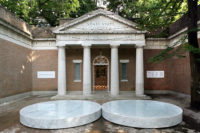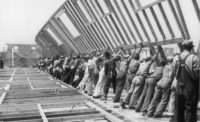Curators Chosen for U.S. Pavilion at 2014 Venice Architectural Biennale

The curators of the United States Pavilion at the 2014 Architecture Biennale in Venice have very ambitious plans: to transform an exhibition space into an architectural office. Announced last week, the State Department’s Bureau of Educational and Cultural Affairs selected the team of Ashley Schafer, Ana Miljački, and Eva Franch i Gilabert and their proposal to reinterpret the last 100 years of American building outside our borders in a project called OfficeUS.
"We want to examine the export product of American architectural firms between 1914 and 2014 through a lens of 'flattening' as a result of the process of Modernity," says Schafer, founder and editor of the architecture journal Praxis. "The U.S. is a prime perpetrator of that condition."
In order to do so, the curators are currently in the process of gathering as many as 1,000 projects to make up what they call the Repository, the exhibition portion of the Pavilion. "We’re interested in how ideas traveled at the beginning of the 20th Century—the 'know-how' of the American office—but also quite literal forms of export like the example of Detroit architect Albert Kahn, who took his expertise designing factories to Russia," says Miljački, assistant professor of architecture at the Massachusetts Institute of Technology.
Beyond merely showcasing these projects, the curators are taking up the call of Rem Koolhaas, director of the 14th International Architecture Exhibition, to "take a fresh look at the fundamental elements of architecture—used by any architect, anywhere, anytime—to see if we can discover something new about architecture." They are setting up an office comprising five fellows who have been out of school for less than 10 years to work on site to reinvent projects from the Repository for the nearly six-month-long duration of the Biennale, from June 7 to November 23, 2014. Additional workers will rotate in on a daily basis, and be visited and critiqued by representatives from other forms of practice outside architecture, including branding agencies, tech incubators, and think thanks, to create a network of expertise.
"Biennales and festivals are meant to create a state of exception," says Gilabert, executive director of Manhattan’s Storefront for Art and Architecture, the institutional sponsor of the exhibit. "We want to create a most exceptional state of production beyond a space of display, a platform for sharing expertise and a moment for reinvention of protocols." Storefront has enlisted Leong Leong, a 2011 Architectural Record Design Vanguard firm, to design the 3,000-square-foot exhibition space, and Natasha Jen of Pentagram to design the identity and environmental graphics.
A press conference with the curators and the OfficeUS team, which also includes Architizer and the journal CLOG, will take place on September 27 at 7 p.m. at Storefront for Art and Architecture in New York.



